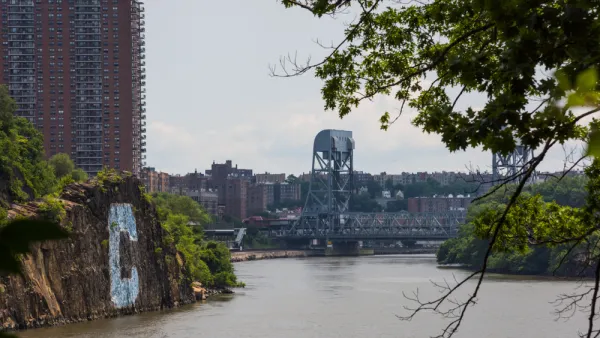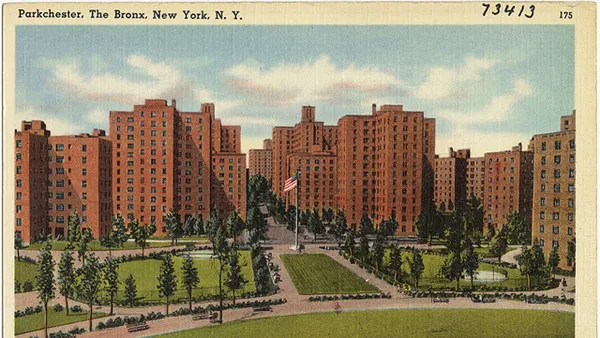The $5.46 billion sale last October for the private 83 acres of Stuyvesant Town and Peter Cooper Village barely topped the prior world record set for the same property in 2006 and preserved 5,000 apartments for middle income renters.
The biggest real estate sale in world history occurred nine years ago, when MetLife sold Stuyvesant Town–Peter Cooper Village, the largest apartment complex in Manhattan, to Tishman Speyer Properties and BlackRock real estate for $5.4 billion.
The properties were resold last October to the Blackstone Group and Ivanhoe Cambridge for $60,000 more, $5.46 billion, although there does seem to be some confusion on the actual price, as Konrad Putzier explains in The Real Deal.
Of far greater consequence is a special agreement in the sale that will allow almost half of the tenants of the 110 buildings and 11,232 apartments on the East Side of Manhattan "stretching from First Avenue to Avenue C, between 14th and 23rd Streets" (per Wikipedia) to sleep easier knowing that the new owners "committed that rents for 5,000 apartments [45%] would remain affordable to middle-class families for the next 20 years," wrote The New York Times' Charles V. Bagli on Oct. 19, 2015.
The agreement represents a victory for (Mayor Bill) de Blasio, who has made affordable housing a central tenet of his administration. Up to now, tenant activists and elected officials have feared that Stuyvesant Town’s 65-year history as a middle-class bastion was ending.
"The agreement also offers new protections for roughly 1,400 'Roberts' units," according to Blackstone's press release on Dec. 18.
Planetizen has no less than nine posts spanning from 2006, just before the first sale of the two private properties by MetLife to to Tishman Speyer Properties and BlackRock real estate, to 2010 when the sale "went kaput after the venture was unable to restructure the $4.4 billion in debt."
"The two properties, built with tax breaks and other subsidies for middle-income residents for returning WWII veterans, stretch over 10 blocks from 14th to 23rd streets," according to the Oct. 19, 2006 post describing the first sale. "They are viewed as among the last remaining middle-class developments on Manhattan."
A last-minute snafu erupted when "SL Green Realty Corporation, New York City’s largest commercial landlord, dropped a bombshell: It told real estate executives and city officials last week that it would file a lawsuit to block the imminent $5.45 billion sale," writes Charles V. Bagli for The New York Times on Dec. 18.
A lawsuit could upend a deal that they had hoped would close the books on one of the biggest financial debacles of the debt-fueled real estate boom in 2006.[...] On Friday afternoon (Dec. 18), the record-breaking sale to Blackstone was completed without any sign of a lawsuit.
Summarizing the record sale from all the stakeholders' perspectives, Douglas Harmon, the broker with Eastdil Secured who organized the Stuyvesant Town sale said, "No stakeholder — the buyers, the seller, bondholders, tenants or politicians — is displeased with the result," writes Bagli.
Of interest to readers may be the roles of two opposing giants in New York urban planning history, Robert Moses and Jane Jacobs. While Moses was a driving force for its creation, Jacobs opposed it due to its lack of street life, as explained in a Gotham Gazette article in 2006 (posted here).
FULL STORY: What’s the deal? Did Stuy Town break a world price record or not?

Analysis: Cybertruck Fatality Rate Far Exceeds That of Ford Pinto
The Tesla Cybertruck was recalled seven times last year.

National Parks Layoffs Will Cause Communities to Lose Billions
Thousands of essential park workers were laid off this week, just before the busy spring break season.

Retro-silient?: America’s First “Eco-burb,” The Woodlands Turns 50
A master-planned community north of Houston offers lessons on green infrastructure and resilient design, but falls short of its founder’s lofty affordability and walkability goals.

Test News Post 1
This is a summary

Analysis: Cybertruck Fatality Rate Far Exceeds That of Ford Pinto
The Tesla Cybertruck was recalled seven times last year.

Test News Headline 46
Test for the image on the front page.
Urban Design for Planners 1: Software Tools
This six-course series explores essential urban design concepts using open source software and equips planners with the tools they need to participate fully in the urban design process.
Planning for Universal Design
Learn the tools for implementing Universal Design in planning regulations.
EMC Planning Group, Inc.
Planetizen
Planetizen
Mpact (formerly Rail~Volution)
Great Falls Development Authority, Inc.
HUDs Office of Policy Development and Research
NYU Wagner Graduate School of Public Service



























